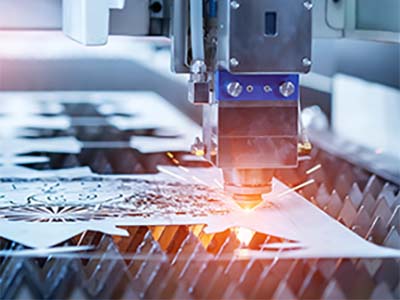Productivity Matters

CO2 versus Fiber-Choosing the Right Laser
Promising New Fiber Technology Changing Industry Perceptions
One of the hottest topics in metal fabricating in recent years has been the growth of fiber laser technology. As often happens with emerging or evolving concepts, there’s a lot of debate and curiosity about the merits of the new machines. Production managers naturally want to know if fiber lasers are better than traditional CO2 lasers, and if so, where and how do they fit? “That whole market is still being defined,” said Larry Cherne, Market Manager, Laser Gases, for Praxair. “The fiber technology keeps getting better and better, but a lot of customers are taking a wait-and-see approach.” CO2 lasers have been the reliable industry standard for decades, so it’s probably safe to assume there won’t be a huge cultural shift overnight. However, fiber lasers are quickly proving they offer distinct advantages in certain applications, especially on thinner materials (less than 5mm).

“For a long time, people said that fiber lasers were only for sheet metal, and there’s some truth to that. If you’re working with less than 12-gauge material, fiber lasers can often cut two or three times faster.”– Larry Cherne, Praxair Market Manager, Laser Gases
Other industry observers agree the thickness of the material you want to cut is a major factor in a fiber vs. CO2 decision. In various comparative tests on thin-gauge metals, fiber lasers were definitely faster at 3mm and provided good edge quality. At 4-5mm the cutting speeds were similar. With materials of 8mm or more, the CO2 machines were consistently more efficient. Fiber lasers also show superiority on many difficult lasing schemes such as low-gain transitions, and fiber has an edge in cutting copper and aluminum alloys.
Energy Efficiency and Other Savings
Fiber lasers represent significant advantages in energy utilization. CO2 lasers generally have about a 10 percent wall-plug efficiency rate (the rate of the energy conversion efficiency with which the system converts electrical power into optical power), but fiber can be more than 25 percent efficient. “Compare that ten percent to a fiber laser where we’re talking about 28 percent energy efficiency,” said Frank Arteaga, Head of Product Marketing at Bystronic, Inc., a leading, worldwide supplier of high-quality laser cutting systems. “That means less input power is required to produce the end results with your output power.” With fiber machinery, the laser beam is transported to the cutting head through a passive fiber, instead of the deflection mirror systems in carbon dioxide lasers. By eliminating the need for mirrors, production managers can lower operating and maintenance costs even further.
Increased Production Flexibility
One area in which fiber lasers have a decided advantage over CO2 equipment is in beam delivery and its various production applications. The light in a fiber laser is able to be much more easily delivered to a movable focusing element, which is important for laser cutting. “The wave of light from a CO2 resonator scatters very easily,” explained Praxair’s Cherne, “but when you’re delivering it through a fiber optic cable, you can literally run it out like an extension cord. Then when you add splitters to the fiber cable, you can divert that beam to different parts of the production floor.” With that split beam, it’s possible to operate multiple tools performing different functions at the same time — such as cutting, drilling and welding — all from a single power source.




























